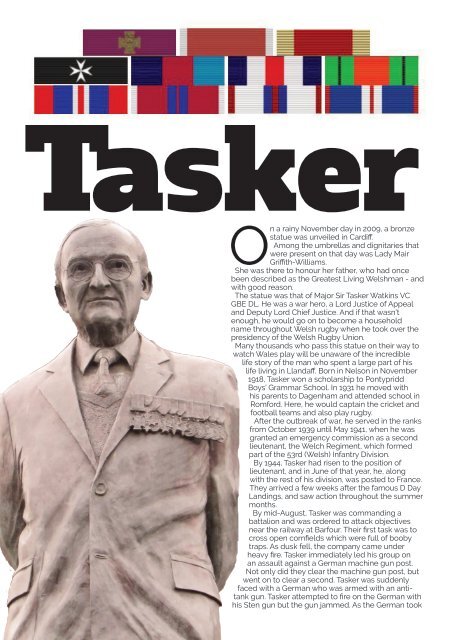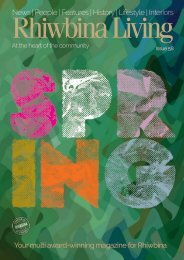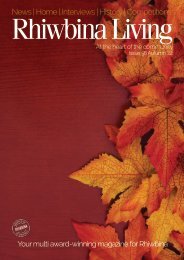Whitchurch and Llandaff Living Issue 56
Winter 2019/20 issue of the award-winning Whitchurch and Llandaff Living.
Winter 2019/20 issue of the award-winning Whitchurch and Llandaff Living.
You also want an ePaper? Increase the reach of your titles
YUMPU automatically turns print PDFs into web optimized ePapers that Google loves.
On a rainy November day in 2009, a bronze<br />
statue was unveiled in Cardiff.<br />
Among the umbrellas <strong>and</strong> dignitaries that<br />
were present on that day was Lady Mair<br />
Griffith-Williams.<br />
She was there to honour her father, who had once<br />
been described as the Greatest <strong>Living</strong> Welshman - <strong>and</strong><br />
with good reason.<br />
The statue was that of Major Sir Tasker Watkins VC<br />
GBE DL. He was a war hero, a Lord Justice of Appeal<br />
<strong>and</strong> Deputy Lord Chief Justice. And if that wasn't<br />
enough, he would go on to become a household<br />
name throughout Welsh rugby when he took over the<br />
presidency of the Welsh Rugby Union.<br />
Many thous<strong>and</strong>s who pass this statue on their way to<br />
watch Wales play will be unaware of the incredible<br />
life story of the man who spent a large part of his<br />
life living in Ll<strong>and</strong>aff. Born in Nelson in November<br />
1918, Tasker won a scholarship to Pontypridd<br />
Boys' Grammar School. In 1931 he moved with<br />
his parents to Dagenham <strong>and</strong> attended school in<br />
Romford. Here, he would captain the cricket <strong>and</strong><br />
football teams <strong>and</strong> also play rugby.<br />
After the outbreak of war, he served in the ranks<br />
from October 1939 until May 1941, when he was<br />
granted an emergency commission as a second<br />
lieutenant, the Welch Regiment, which formed<br />
part of the 53rd (Welsh) Infantry Division.<br />
By 1944, Tasker had risen to the position of<br />
lieutenant, <strong>and</strong> in June of that year, he, along<br />
with the rest of his division, was posted to France.<br />
They arrived a few weeks after the famous D Day<br />
L<strong>and</strong>ings, <strong>and</strong> saw action throughout the summer<br />
months.<br />
By mid-August, Tasker was comm<strong>and</strong>ing a<br />
battalion <strong>and</strong> was ordered to attack objectives<br />
near the railway at Barfour. Their first task was to<br />
cross open cornfields which were full of booby<br />
traps. As dusk fell, the company came under<br />
heavy fire. Tasker immediately led his group on<br />
an assault against a German machine gun post.<br />
Not only did they clear the machine gun post, but<br />
went on to clear a second. Tasker was suddenly<br />
faced with a German who was armed with an antitank<br />
gun. Tasker attempted to fire on the German with<br />
his Sten gun but the gun jammed. As the German took


















